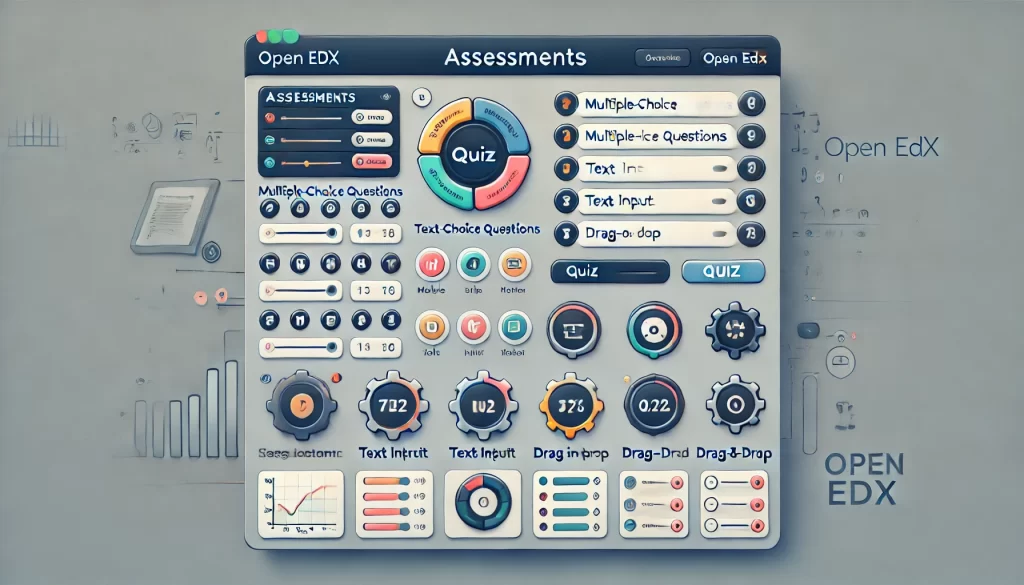How to set up and manage assessments and quizzes in Open edX?
Open edX is a key part of creating an engaging and effective learning experience. Open edX provides a variety of tools to create, configure, and manage assessments, including quizzes, exams, and peer assessments. Below is a step-by-step guide to setting up and managing assessments and quizzes in Open edX.

Step 1: Access Open edX Studio
- Log in to Studio:
- Navigate to your Open edX Studio instance (e.g.,
https://<your-domain>:8001). - Log in using your instructor or admin credentials.
2. Open Your Course:
- Select the course where you want to create assessments.
Step 2: Create Assessments
Assessments are added to Units within Subsections. Follow these steps to create assessments:
- Navigate to the Course Outline:
- In Studio, go to the Course Outline tab.
2. Add a Subsection:
- Create a new subsection (e.g., “Quiz 1”) or use an existing one.
3. Add a Unit:
- Inside the subsection, add a new unit (e.g., “Multiple Choice Questions”).
4. Add Assessment Components:
- Click Add Component in the unit to add different types of assessments:
- Problem: For quizzes and interactive questions.
- Discussion: For discussion-based assessments.
- Advanced: For custom components like XBlocks.
Step 3: Configure Quizzes and Problems
Open edX supports a variety of problem types for quizzes. Here’s how to configure them:
- Multiple Choice:
- Select Problem > Multiple Choice.
- Enter the question and answer options.
- Specify the correct answer(s) and provide feedback.
2. Checkboxes:
- Select Problem > Checkboxes.
- Allow learners to select multiple correct answers.
3. Dropdown:
- Select Problem > Dropdown.
- Provide a dropdown menu for learners to select the correct answer.
4. Numerical Input:
- Select Problem > Numerical Input.
- Specify the correct answer and tolerance range.
5. Text Input:
- Select Problem > Text Input.
- Define the correct answer and matching rules (exact or regex).
6. Math Expression Input:
- Select Problem > Math Expression Input.
- Use a math engine to evaluate mathematical expressions.
7. Drag and Drop:
- Select Problem > Drag and Drop.
- Create interactive drag-and-drop activities.
8. Custom JavaScript Problems:
- Use Advanced > Custom JavaScript to create custom interactive problems.
Step 4: Set Up Grading
- Configure Grading Policy:
- Go to the Settings tab in Studio.
- Under Grading, configure the grading policy:
- Assign weights to different types of assessments (e.g., quizzes, exams, assignments).
- Set the passing score for the course.
2. Grade Individual Problems:
- Each problem can be assigned a point value.
- Specify whether partial credit is allowed for multi-part questions.
Step 5: Publish Assessments
- Publish Content:
- After creating assessments, click Publish to make them visible to learners.
- Ensure all units, subsections, and sections are published.
2. Preview Assessments:
- Use the Preview button to test how assessments will appear to learners.
Step 6: Manage Assessments
- Monitor Submissions:
- Use the Instructor Dashboard in the LMS to track learner submissions and grades.
- Navigate to Instructor > Student Admin > View Gradebook.
2. Regrade Assessments:
- If needed, regrade assessments from the Instructor Dashboard:
- Go to Instructor > Data Download > Grading Configuration.
- Upload a CSV file with updated grades.
3. Provide Feedback:
- Add feedback to individual submissions to help learners improve.
Step 7: Advanced Assessment Features
- Timed Exams:
- Set time limits for exams or quizzes:
- In Studio, go to the Settings tab.
- Enable Timed Exams and specify the time limit.
2. Proctored Exams:
- Enable proctoring to ensure academic integrity:
- Integrate with a proctoring service (e.g., ProctorU, Examity).
- Configure proctoring settings in the Instructor Dashboard.
3. Peer Assessments:
- Set up peer assessments for assignments:
- In Studio, add a Peer Assessment component.
- Define the rubric and grading criteria.
4. Self-Assessments:
- Allow learners to evaluate their own work:
- Add a Self-Assessment component in Studio.
Step 8: Analyze Assessment Data
- View Analytics:
- Use the Instructor Dashboard to analyze learner performance:
- Navigate to Instructor > Data Download > Problem Grade Report.
2. Export Data:
- Export assessment data (e.g., grades, submissions) for further analysis:
- Go to Instructor > Data Download and download the relevant reports.
Step 9: Best Practices for Assessments
- Align Assessments with Learning Objectives:
- Ensure assessments measure the intended learning outcomes.
- Use a Variety of Question Types:
- Mix multiple-choice, text input, and interactive problems to engage learners.
- Provide Clear Instructions:
- Include detailed instructions for each assessment.
- Test Assessments:
- Preview and test all assessments before publishing.
- Offer Feedback:
- Provide constructive feedback to help learners improve.